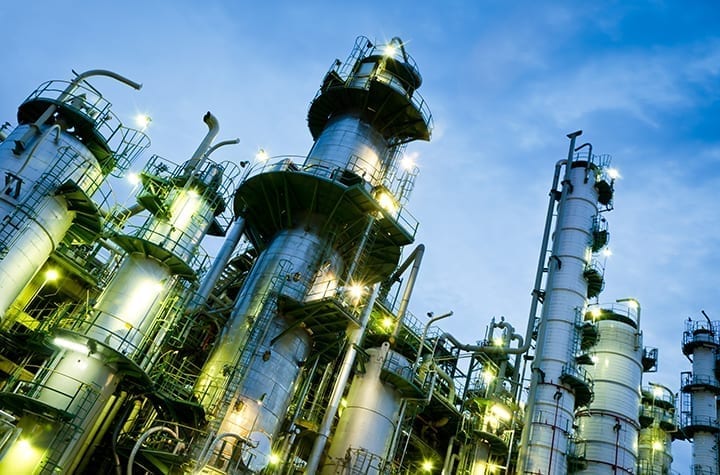The Benefits of Explosion-Protected Cameras in High-Risk Environments

Many critical infrastructure sites contain areas that are classified as hazardous due to a high risk of explosion. What makes most of these locations dangerous is the presence of flammable materials such as liquids, gases, vapors, and dust.
In these areas, the use of network cameras can significantly improve the overall health and safety posture of a site by providing remote monitoring and remote maintenance capabilities, helping to detect and potentially prevent an explosion before it happens (or spreads). It is imperative, however, that the specific surveillance equipment used in such hazardous areas is designed to be explosion protected.
An explosion-protected network camera has a heavy-duty enclosure, or camera housing, usually made from stainless steel or aluminum and certified for use in hazardous environments where flammable material may be present. Supervisory control and data acquisition (SCADA) allows easy monitoring of all equipment and processes from one convenient location. As a result, explosion-protected cameras can be placed in even the most hazardous environments.
Benefits of Explosion Protected Cameras in Hazardous AreasBy nature, hazardous areas are those where personnel should spend little, if any, time, but it is important that these areas remain under 24/7 surveillance in case of an emergency situation. Due to their versatility, explosion-protected cameras offer myriad benefits to drive end-to-end safety from the perimeter all the way to the critical core of a hazardous site. These benefits include:
- Remote Monitoring. The use of a network video surveillance system enables operators to connect to real-time video from any authorized computer anywhere in the world. This is especially valuable in hazardous environments because it allows for off-site monitoring and maintenance of facilities. This means less time spent inside hazardous areas for service personnel, as well as less operational downtime. High-quality images from network surveillance cameras allow remote visual monitoring and verification in forensic detail, allowing operators to assess exactly if and when intervention by personnel is re When hands-on maintenance is required, anyone working in a hazardous area can also be monitored remotely. Moreover, end users can access data from SCADA systems within the camera for thermal or visual verification, mitigating the need for a person having to gear up and enter restricted areas. This is made possible via the explosion protected housing that allows the sensor and camera to be placed in hazardous areas in the first place.
- Video Analytics for Increased Safety. Beyond the benefits of remote monitoring, today's explosion-protected network cameras have deep learning capabilities and advanced, built-in video analytics able to analyze video and sensor input to detect unusual activity, trends, and anomalies within the defined area. Motion analytics can detect who enters and leaves a hazardous site, or recognize when someone is trying to enter a restricted area. Moreover, advanced video analytics can detect the presence of smoke or gas and signal an alert to the appropriate parties to mitigate potential danger before it escalates. Smoke detection is a prime example: explosion-protected cameras can be equipped with analytics that rely on visual contrast within the image, meaning that the cameras themselves do not have to come into contact with smoke to detect it.
- Advanced Integration. The network camera provides a high level of seamless integration with other devices, including sensors, alarms, audio, and access control. This network of connected devices, each with a specific purpose, enables operators to better protect their facilities with a multi-layered security approach. If an abnormality or potentially dangerous situation is detected, the devices can communicate with one another and respond based on the situation at hand. For example, a gas sensor might detect a leak, which would set off a chain reaction within the network, alerting personnel to the danger, utilizing cameras to detect people in the area in question, and broadcasting an evacuation message over the audio speakers. Heat and thermal sensors can be added to the network to detect if the temperature of equipment moves beyond a safe threshold, and even potentially shut off the machine or reduce its power. Thermal sensors mimic regular cameras by creating images, but do so in a unique manner, through heat radiation. With thermal devices, operators can ensure processes run smoothly by detecting leaky pipes and dangerous temperature levels, and taking the necessary precautions. In all, the chorus of devices seamlessly work together to monitor, detect, and alert staff to potential issues in hazardous areas, and subsequently assess and respond to the situation with the best course of action.
The remote monitoring, video analytics, and advanced integration capabilities of explosion-protected cameras, coupled with their heavy-duty design, helps to bolster the end-to-end safety and security of hazardous sites, limit the onsite presence of personnel, and mitigate the impact of events that might otherwise prove catastrophic. Although safety and security are considered a high priority in hazardous areas, too many organizations continue to leave themselves vulnerable by relying on cameras placed outside those areas, rather than investing in explosion-protected devices. This may result in short-term savings, but reduces the level of detail captured and intelligence collected. As the beyond video" capabilities of explosion-protected cameras continue to grow, the benefits they offer within hazardous areas will continue to multiply, and their role and impact in the critical infrastructure industry will be pivotal to bolster holistic safety and security efforts.
-Joe Morgan is segment development manager for critical infrastructure in the Americas at Axis Communications.
The post The Benefits of Explosion-Protected Cameras in High-Risk Environments appeared first on POWER Magazine.